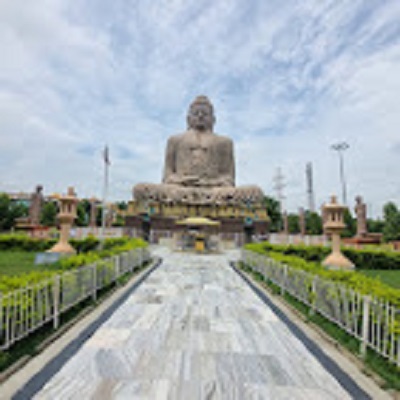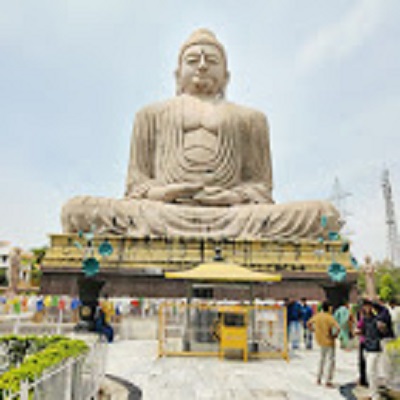Inside Area

The 80-feet Buddha statue in Bodhgaya, Bihar, is located within a beautifully designed spiritual complex that covers a vast area filled with greenery and tranquility. This grand statue, seated in a meditative pose on a lotus pedestal, is surrounded by a well-maintained garden, stone pathways, and quiet zones for prayer and reflection. The entire complex exudes peace, making it an ideal place for visitors seeking spiritual calm. Around the main statue are ten smaller statues representing Buddha’s chief disciples, symbolizing the Sangha and the journey of enlightenment. Benches, prayer wheels, and informational boards guide visitors through the space. The complex is often visited by pilgrims, monks, and tourists from around the world who come to experience the calm and spiritual energy of the site. Located close to the Mahabodhi Temple, this area forms an important part of Bodhgaya’s sacred landscape and stands as a symbol of devotion, history, and universal peace.
Other Attractions
Apart from the magnificent 80-feet Buddha statue, the surrounding complex offers several attractions that enhance the spiritual and cultural experience. One of the key highlights is the row of ten smaller statues of Lord Buddha’s principal disciples, placed around the main statue, each crafted with fine detail. The peaceful gardens and well-paved walkways invite visitors to sit, meditate, or walk mindfully. The area also features beautiful stone carvings, prayer wheels, and small shrines that reflect the teachings of Buddhism. At times, one can witness chanting and prayer ceremonies conducted by monks from different countries. Nearby souvenir shops offer books, statues, and handicrafts. Being close to other sacred sites like the Mahabodhi Temple, Thai Monastery, Tibetan Monastery, and Japanese Temple, the area around the 80-feet Buddha becomes a central spiritual hub, offering visitors a rich and peaceful experience of Bodhgaya’s divine heritage.

Distance From
Gaya Railway Station
The distance from Gaya Railway Station to the 80-feet Buddha Statue in Bodhgaya is approximately 15 km

Gaya Airport
The distance from Gaya International Airport to the 80-feet Buddha Statue is approximately 10 km,

Gaya Bus Stand
The distance from Sikariya More Bus Stand (Gaya city) to the 80‑feet Buddha Statue in Bodhgaya is approximately 11 km,

Our Review
The 80-feet Buddha Statue in Bodhgaya is a magnificent symbol of peace and spirituality. Unveiled on 18th November 1989 by the 14th Dalai Lama, the statue was constructed over seven years by the Daijokyo Buddhist sect of Japan. Made from red granite and sandstone, it depicts Lord Buddha in a meditative posture seated on a grand lotus pedestal. Surrounded by a peaceful garden and ten smaller statues representing Buddha’s disciples, the site offers a calm and reflective atmosphere for visitors. Located close to the Mahabodhi Temple, this statue has become a major attraction and spiritual landmark. Visitors consistently praise its serene environment, well-maintained surroundings, and the powerful sense of devotion it inspires. The overall experience leaves a lasting impression on those who visit, making it not just a place to see, but a place to feel peace, reflection, and connection with the timeless teachings of Buddha.
